Data Structures and Algorithms
- Introduction to Data Structures and Algorithms
- Time and Space Complexity Analysis
- Big-O, Big-Theta, and Big-Omega Notations
- Recursion and Backtracking
- Divide and Conquer Algorithm
- Dynamic Programming: Memoization vs. Tabulation
- Greedy Algorithms and Their Use Cases
- Understanding Arrays: Types and Operations
- Linear Search vs. Binary Search
- Sorting Algorithms: Bubble, Insertion, Selection, and Merge Sort
- QuickSort: Explanation and Implementation
- Heap Sort and Its Applications
- Counting Sort, Radix Sort, and Bucket Sort
- Hashing Techniques: Hash Tables and Collisions
- Open Addressing vs. Separate Chaining in Hashing
- DSA Questions for Beginners
- Advanced DSA Questions for Competitive Programming
- Top 10 DSA Questions to Crack Your Next Coding Test
- Top 50 DSA Questions Every Programmer Should Practice
- Top Atlassian DSA Interview Questions
- Top Amazon DSA Interview Questions
- Top Microsoft DSA Interview Questions
- Top Meta (Facebook) DSA Interview Questions
- Netflix DSA Interview Questions and Preparation Guide
- Top 20 DSA Interview Questions You Need to Know
- Top Uber DSA Interview Questions and Solutions
- Google DSA Interview Questions and How to Prepare
- Airbnb DSA Interview Questions and How to Solve Them
- Mobile App DSA Interview Questions and Solutions
DSA Interview Questions
- DSA Questions for Beginners
- Advanced DSA Questions for Competitive Programming
- Top 10 DSA Questions to Crack Your Next Coding Test
- Top 50 DSA Questions Every Programmer Should Practice
- Top Atlassian DSA Interview Questions
- Top Amazon DSA Interview Questions
- Top Microsoft DSA Interview Questions
- Top Meta (Facebook) DSA Interview Questions
- Netflix DSA Interview Questions and Preparation Guide
- Top 20 DSA Interview Questions You Need to Know
- Top Uber DSA Interview Questions and Solutions
- Google DSA Interview Questions and How to Prepare
- Airbnb DSA Interview Questions and How to Solve Them
- Mobile App DSA Interview Questions and Solutions
Data Structures and Algorithms
- Introduction to Data Structures and Algorithms
- Time and Space Complexity Analysis
- Big-O, Big-Theta, and Big-Omega Notations
- Recursion and Backtracking
- Divide and Conquer Algorithm
- Dynamic Programming: Memoization vs. Tabulation
- Greedy Algorithms and Their Use Cases
- Understanding Arrays: Types and Operations
- Linear Search vs. Binary Search
- Sorting Algorithms: Bubble, Insertion, Selection, and Merge Sort
- QuickSort: Explanation and Implementation
- Heap Sort and Its Applications
- Counting Sort, Radix Sort, and Bucket Sort
- Hashing Techniques: Hash Tables and Collisions
- Open Addressing vs. Separate Chaining in Hashing
- DSA Questions for Beginners
- Advanced DSA Questions for Competitive Programming
- Top 10 DSA Questions to Crack Your Next Coding Test
- Top 50 DSA Questions Every Programmer Should Practice
- Top Atlassian DSA Interview Questions
- Top Amazon DSA Interview Questions
- Top Microsoft DSA Interview Questions
- Top Meta (Facebook) DSA Interview Questions
- Netflix DSA Interview Questions and Preparation Guide
- Top 20 DSA Interview Questions You Need to Know
- Top Uber DSA Interview Questions and Solutions
- Google DSA Interview Questions and How to Prepare
- Airbnb DSA Interview Questions and How to Solve Them
- Mobile App DSA Interview Questions and Solutions
DSA Interview Questions
- DSA Questions for Beginners
- Advanced DSA Questions for Competitive Programming
- Top 10 DSA Questions to Crack Your Next Coding Test
- Top 50 DSA Questions Every Programmer Should Practice
- Top Atlassian DSA Interview Questions
- Top Amazon DSA Interview Questions
- Top Microsoft DSA Interview Questions
- Top Meta (Facebook) DSA Interview Questions
- Netflix DSA Interview Questions and Preparation Guide
- Top 20 DSA Interview Questions You Need to Know
- Top Uber DSA Interview Questions and Solutions
- Google DSA Interview Questions and How to Prepare
- Airbnb DSA Interview Questions and How to Solve Them
- Mobile App DSA Interview Questions and Solutions
Next.js 15 vs. Remix: Which Framework Should You Learn in 2025?
In the fast-paced world of web development, selecting the right framework can make or break your project. As we navigate 2025, two React-based frameworks stand out: Next.js 15 and Remix. Both empower developers to build modern, full-stack applications, but they differ in philosophy, features, and use cases. This comprehensive guide compares Next.js 15 and Remix, helping you decide which framework to learn based on your project needs and career goals. Whether you’re building a high-performance e-commerce site or a content-driven blog, this article will provide the insights you need.
To enhance your web development skills and stay ahead of the curve, sign up for our free courses to explore the latest trends and technologies.
Understanding Next.js 15
Next.js, developed by Vercel, is a mature React framework known for its flexibility, performance optimizations, and extensive feature set. Released on October 21, 2024, Next.js 15 builds on its predecessors with significant updates, making it a go-to choice for developers worldwide.
Key Features of Next.js 15
- React 19 Support: Integrates with React 19, offering improved hydration, error handling, and experimental React Compiler support for enhanced performance.
- Turbopack for Builds: Introduces Turbopack, a Rust-based bundler that replaces Webpack, significantly speeding up development and production builds.
- Improved Caching: Enhanced caching mechanisms reduce load times and improve scalability, with no default caching for fetch requests, GET Route Handlers, and client navigations.
- Async Request APIs: Simplifies rendering and caching with new asynchronous APIs, streamlining data handling.
- Parallel Routes: Enables simultaneous loading of multiple page sections, improving responsiveness and user experience.
Recent Updates and Improvements
Since its release, Next.js 15 has seen updates like versions 15.1, 15.2, and 15.3, focusing on stability and developer experience. Key improvements include better error debugging, stable after API for deferred tasks, and TypeScript plugin enhancements for large codebases. These updates make Next.js 15 a robust choice for modern web applications.
Use Cases and Strengths
Next.js 15 excels in scenarios requiring:
- SEO Optimization: Its SSR and SSG capabilities ensure fast page loads and search engine visibility.
- Scalability: Ideal for large-scale applications like e-commerce platforms and media sites.
- Developer Productivity: Extensive documentation and a vast ecosystem simplify development.
For those looking to master Next.js, our web development course provides hands-on training to build scalable applications.
Understanding Remix
Remix, created by the React Router team and acquired by Shopify in 2022, is a full-stack web framework that prioritizes web standards and performance. It’s designed to deliver fast, resilient user experiences with minimal JavaScript.
Key Features of Remix
- Server-Side Rendering (SSR): Renders pages on the server, reducing client-side JavaScript for faster initial loads and better SEO.
- Nested Routes: Supports complex routing hierarchies, enabling efficient data loading for nested layouts.
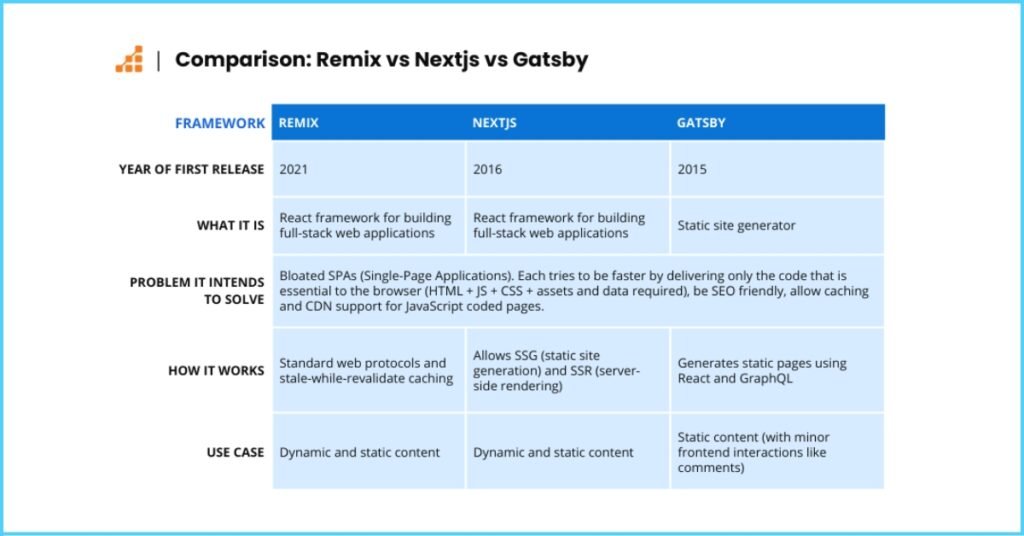
- Automatic Data Loading: Uses loaders and actions to streamline data fetching, minimizing manual state management.
- Error Boundaries: Built-in error handling ensures applications remain stable even when issues arise.
- Deployment Flexibility: Runs on any JavaScript-supporting platform, avoiding vendor lock-in.
Philosophy and Approach
Remix’s philosophy centers on leveraging web fundamentals like HTTP, caching, and browser-native features. It ensures applications work without JavaScript, progressively enhancing functionality for better accessibility and performance. This approach appeals to developers who value simplicity and resilience.
Use Cases and Strengths
Remix shines in:
- Performance-Critical Applications: Ideal for real-time dashboards and data-heavy platforms.
- Accessibility: Supports traditional form submissions, enhancing usability for all users.
- Complex Data Handling: Simplifies data fetching for intricate applications.
To dive into Remix, check out our crash course for a quick start on modern frameworks.
Comparing Next.js 15 and Remix
To choose the right framework, let’s compare Next.js 15 and Remix across key dimensions: performance, data fetching, routing, developer experience, deployment, and community support.
Performance Comparison
Both frameworks prioritize performance but take different approaches:
Aspect | Next.js 15 | Remix |
Rendering | Supports SSR, SSG, and ISR for flexible performance optimization. | Focuses on SSR, minimizing client-side JavaScript for faster initial loads. |
Build Speed | Turbopack accelerates builds, with over 50% of development sessions using it. | Uses Vite for fast builds, leveraging web standards for efficiency. |
Load Times | Parallel Routes and streaming improve perceived load times. | Edge-first architecture ensures quick loads, even on slow networks. |
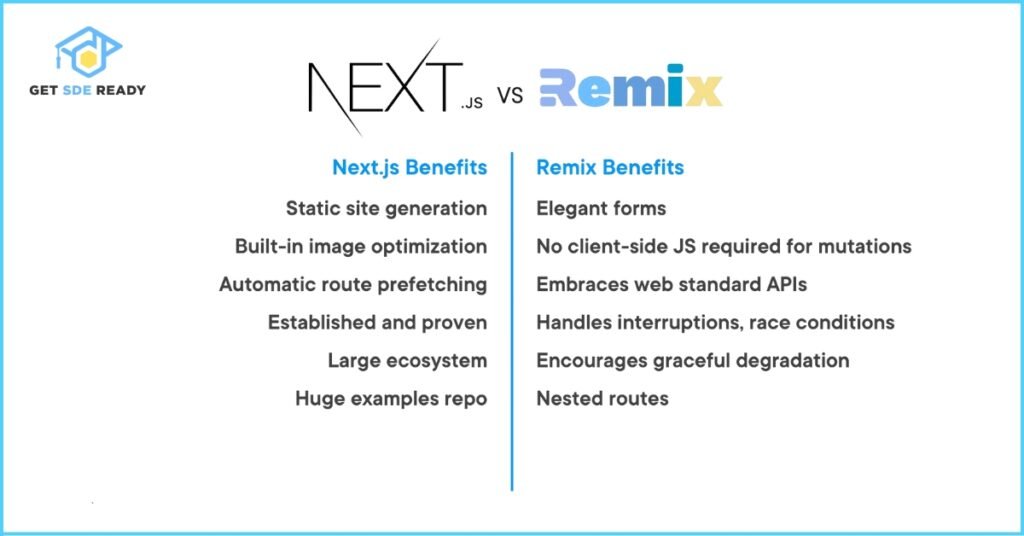
Analysis: Next.js 15 offers versatility with multiple rendering options, while Remix’s SSR focus excels in low-JavaScript scenarios. For performance-critical projects, Remix may have a slight edge on slow networks, but Next.js 15’s Turbopack makes it competitive for large-scale builds.
Data Fetching and Handling
Data management is crucial for modern web applications. Here’s how the frameworks compare:
Aspect
Next.js 15
Remix
Data Fetching
Uses getServerSideProps, getStaticProps, and API routes for flexibility.
Loaders and actions automate data fetching, integrated with routing.
State Management
Requires manual setup or libraries like SWR for client-side data reuse.
Automatically handles data loading, reducing state management complexity.
Dynamic Data
Supports ISR for dynamic updates without full rebuilds.
Parallel data loading for nested routes optimizes performance.
Analysis: Remix’s automatic data loading simplifies development, especially for complex applications. Next.js 15 offers more control but requires additional configuration. For data-heavy projects, Remix’s approach may save time.
Routing and Navigation
Routing defines how users navigate your application:
Aspect
Next.js 15
Remix
Routing System
File-based routing in the pages or app directory, with dynamic routes.
File-based routing with nested routes for complex hierarchies.
Navigation
Supports client-side navigation with useRouter hook.
Leverages React Router v7 for seamless navigation and data reuse.
Complexity
Limited support for nested routes, requiring workarounds.
Native nested routes simplify building intricate layouts.
Analysis: Remix’s nested routing is a standout for applications with complex layouts, while Next.js 15’s simpler routing suits straightforward projects. For advanced routing needs, Remix is more intuitive.
Developer Experience
A smooth developer experience (DX) boosts productivity:
Aspect
Next.js 15
Remix
Ease of Use
Extensive documentation and plugins streamline development.
Simplified data handling and web standards enhance DX.
Learning Curve
Familiar to React developers but requires learning rendering options.
Unique approach may require adjustment, but clear docs help.
Tooling
TypeScript support, ESLint 9, and codemod CLI for upgrades.
Vite-based tooling and Shopify-backed development ensure reliability.
Analysis: Next.js 15’s mature ecosystem and documentation make it accessible, while Remix’s focus on simplicity appeals to developers who prefer minimal setup. Both are approachable with React knowledge, which you can deepen with our master DSA and web dev course.
Deployment Options
Deployment flexibility impacts scalability and cost:
Aspect
Next.js 15
Remix
Primary Platform
Optimized for Vercel, with support for other platforms via OpenNext.
Deployable anywhere (Cloudflare, Netlify, AWS) without vendor lock-in.
Cost
Vercel’s pricing can be high for large projects (e.g., $40k quoted for some).
Generally cheaper due to flexible deployment options.
Ease of Deployment
Vercel offers a seamless “Develop, Preview, Ship” experience.
Multiple platform templates simplify deployment setup.
Analysis: Remix’s platform-agnostic design offers cost-effective scaling, while Next.js 15’s Vercel integration is convenient but may tie you to their pricing. For budget-conscious projects, Remix is more flexible.
Community and Ecosystem
Community support drives long-term success:
Aspect
Next.js 15
Remix
Community Size
Large, with over 116,000 npm projects and extensive resources.
Smaller but growing, backed by Shopify and React Router community.
Resources
Abundant tutorials, plugins, and third-party integrations.
Growing documentation and community support, but fewer resources.
Maintenance
Actively maintained by Vercel with frequent updates.
Shopify’s acquisition ensures ongoing development and innovation.
Analysis: Next.js 15’s larger community provides more resources, making it easier to find solutions. Remix’s community is smaller but vibrant, with Shopify’s support ensuring future growth.
Which Framework Should You Learn in 2025?
Choosing between Next.js 15 and Remix depends on your project requirements, team expertise, and long-term goals.
Factors to Consider
- Performance Needs: Remix’s minimal JavaScript and edge-first approach excel in performance-critical scenarios, while Next.js 15’s rendering options offer flexibility.
- Data Complexity: Remix simplifies complex data fetching, ideal for real-time or data-heavy applications. Next.js 15 suits projects needing custom data strategies.
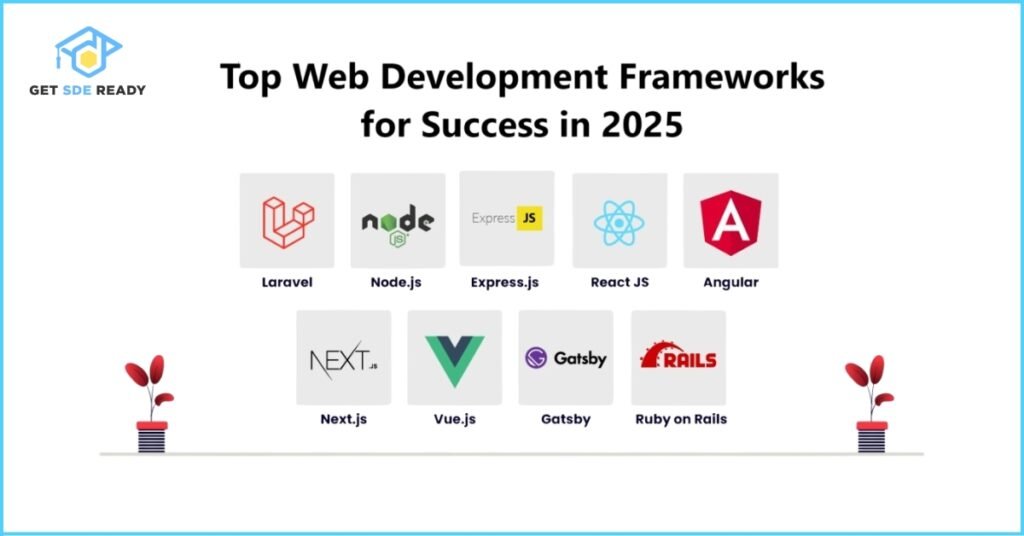
- Routing Complexity: Remix’s nested routes are perfect for intricate layouts, while Next.js 15’s simpler routing works for straightforward sites.
- Deployment Flexibility: Remix’s platform-agnostic design avoids vendor lock-in, while Next.js 15 is optimized for Vercel but adaptable.
- Community Support: Next.js 15’s larger ecosystem is ideal for beginners or teams needing extensive resources, while Remix’s growing community suits innovators.
Recommendations
- Learn Next.js 15 if: You’re building scalable applications, value a large community, or prefer Vercel’s deployment ecosystem. It’s ideal for e-commerce, media sites, or projects requiring SSR and SSG. Start with our web development course to master Next.js.
- Learn Remix if: You prioritize performance, accessibility, or deployment flexibility. It’s perfect for real-time dashboards, data-heavy apps, or projects needing nested routes. Try our crash course to get started with Remix.
- Consider Both: If you’re a versatile developer, learning both frameworks can broaden your skill set. Combine them with data structures knowledge from our DSA course for a well-rounded expertise.
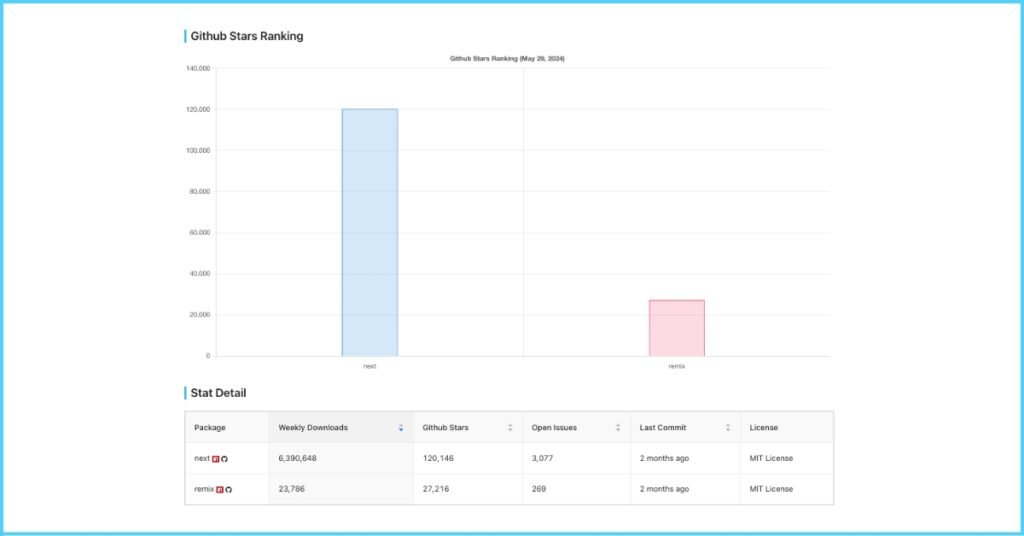
Future Trends and Developments
Both frameworks are evolving rapidly. Next.js 15’s Turbopack and React 19 integration signal a focus on performance and developer experience. Remix’s merger with React Router v7 (announced at React Conf 2024) suggests deeper integration with React’s ecosystem. Monitoring their roadmaps will keep you ahead of the curve.
Conclusion
Next.js 15 and Remix are powerful React frameworks with distinct strengths. Next.js 15 offers a mature ecosystem, versatile rendering options, and seamless Vercel integration, making it ideal for large-scale, SEO-driven projects. Remix excels in performance, accessibility, and deployment flexibility, perfect for data-heavy or real-time applications. Your choice depends on your project’s needs, team expertise, and deployment preferences.
Whichever framework you choose, mastering modern web development is key to staying competitive. Explore our data science course to complement your skills with data-driven insights, or dive into our master DSA and web dev course for a comprehensive learning journey.
FAQs
What is the main difference between Next.js and Remix?
Next.js is a React framework with features like SSR, SSG, and API routes, while Remix is a full-stack framework emphasizing web standards and automatic data loading.
Which framework is better for SEO?
Both support SEO through SSR and SSG, but Remix’s minimal JavaScript approach may offer a slight edge for accessibility and initial load times.
Can I use Next.js or Remix with other databases?
Yes, both integrate with various databases. Next.js uses API routes, while Remix leverages loaders and actions for seamless data fetching.
Is Remix easier to learn than Next.js?
The learning curve depends on React familiarity. Remix’s web standards focus may require adjustment, but both have clear documentation.
Which framework has better deployment options?
Remix offers more flexibility, deployable on any JavaScript-supporting platform, while Next.js is optimized for Vercel but adaptable with effort.

DSA, High & Low Level System Designs
- 85+ Live Classes & Recordings
- 24*7 Live Doubt Support
- 400+ DSA Practice Questions
- Comprehensive Notes
- HackerRank Tests & Quizzes
- Topic-wise Quizzes
- Case Studies
- Access to Global Peer Community
Buy for 60% OFF
₹25,000.00 ₹9,999.00
Accelerate your Path to a Product based Career
Boost your career or get hired at top product-based companies by joining our expertly crafted courses. Gain practical skills and real-world knowledge to help you succeed.
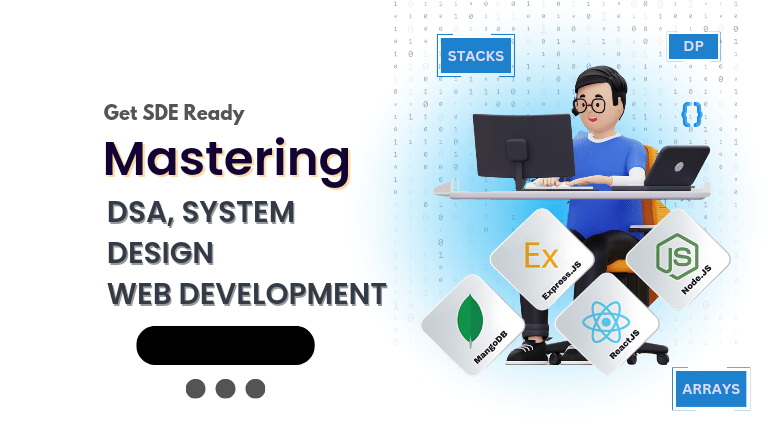
Fast-Track to Full Spectrum Software Engineering
- 120+ Live Classes & Recordings
- 24*7 Live Doubt Support
- 400+ DSA Practice Questions
- Comprehensive Notes
- HackerRank Tests & Quizzes
- 12+ live Projects & Deployments
- Case Studies
- Access to Global Peer Community
Buy for 57% OFF
₹35,000.00 ₹14,999.00

DSA, High & Low Level System Designs
- 85+ Live Classes & Recordings
- 24*7 Live Doubt Support
- 400+ DSA Practice Questions
- Comprehensive Notes
- HackerRank Tests & Quizzes
- Topic-wise Quizzes
- Case Studies
- Access to Global Peer Community
Buy for 60% OFF
₹25,000.00 ₹9,999.00
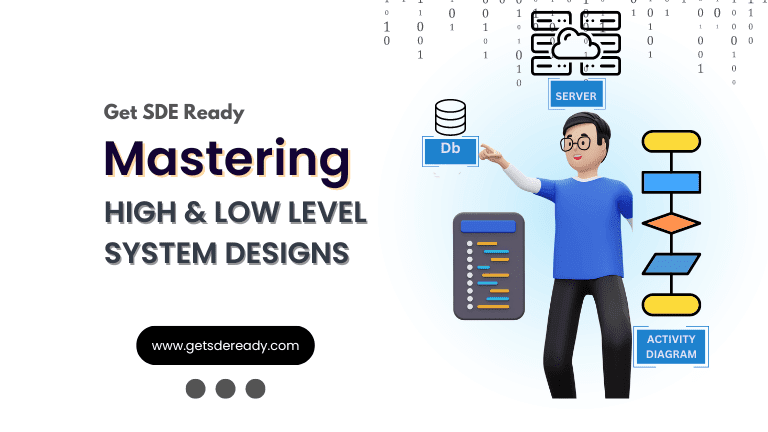
Low & High Level System Design
- 20+ Live Classes & Recordings
- 24*7 Live Doubt Support
- Case Studies
- Comprehensive Notes
- HackerRank Tests
- Topic-wise Quizzes
- Access to Global Peer Community
- Interview Prep Material
Buy for 65% OFF
₹20,000.00 ₹6,999.00
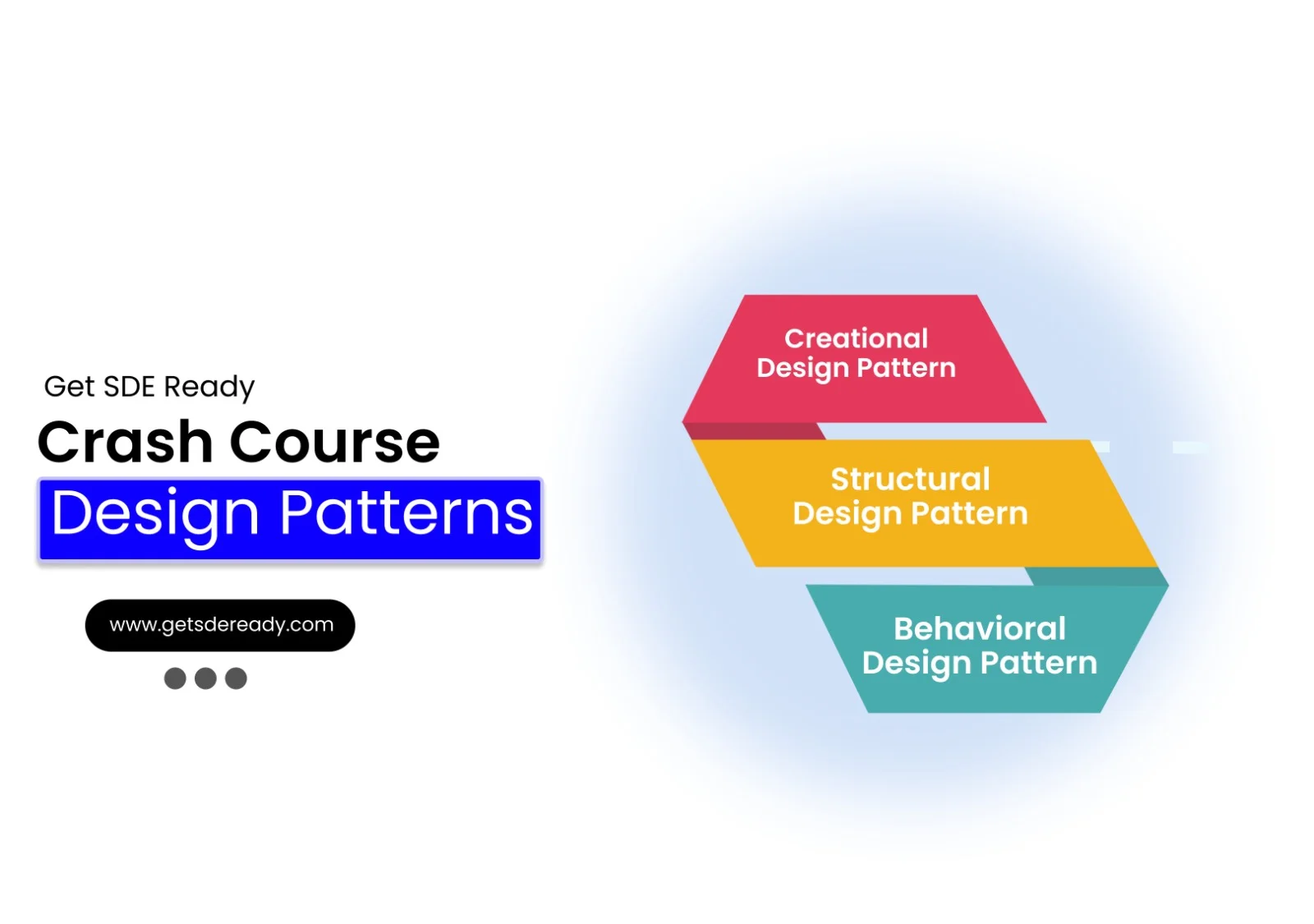
Design Patterns Bootcamp
- Live Classes & Recordings
- 24/7 Live Doubt Support
- Practice Questions
- Case Studies
- Access to Global Peer Community
- Topic wise Quizzes
- Referrals
- Certificate of Completion
Buy for 50% OFF
₹2,000.00 ₹999.00

LLD Bootcamp
- 7+ Live Classes & Recordings
- Practice Questions
- 24/7 Live Doubt Support
- Case Studies
- Topic wise Quizzes
- Access to Global Peer Community
- Certificate of Completion
- Referrals
Buy for 50% OFF
₹2,000.00 ₹999.00

Essentials of Machine Learning and Artificial Intelligence
- 65+ Live Classes & Recordings
- 24*7 Live Doubt Support
- 22+ Hands-on Live Projects & Deployments
- Comprehensive Notes
- Topic-wise Quizzes
- Case Studies
- Access to Global Peer Community
- Interview Prep Material
Buy for 65% OFF
₹20,000.00 ₹6,999.00
Reach Out Now
If you have any queries, please fill out this form. We will surely reach out to you.
Contact Email
Reach us at the following email address.
arun@getsdeready.com
Phone Number
You can reach us by phone as well.
+91-97737 28034
Our Location
Rohini, Sector-3, Delhi-110085